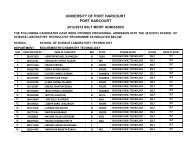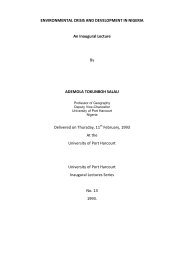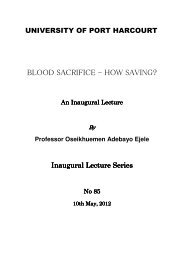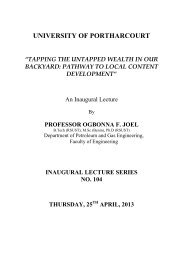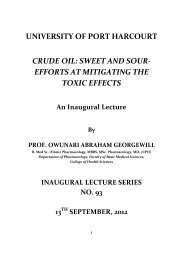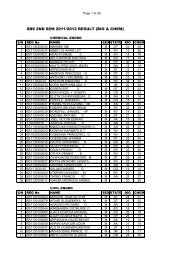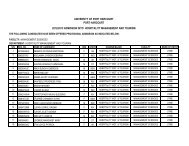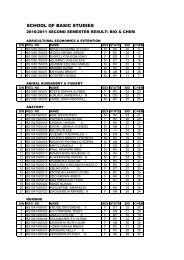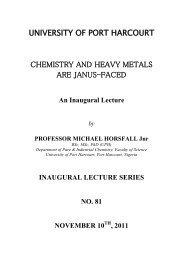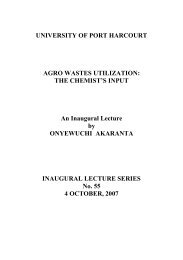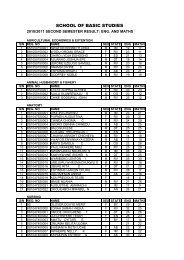6th Inaugural Lecture - 1987 by Prof. Emmanuel O. Anosike
6th Inaugural Lecture - 1987 by Prof. Emmanuel O. Anosike
6th Inaugural Lecture - 1987 by Prof. Emmanuel O. Anosike
You also want an ePaper? Increase the reach of your titles
YUMPU automatically turns print PDFs into web optimized ePapers that Google loves.
UNIVERSITY OF PORT HARCOURTIN PRAISE OFENZYMESEMMANUEL O. ANOSIKEINAUGURAL LECTURE <strong>1987</strong>NO. 6
IN PRAISE OF ENZYMESEMMANUEL O. ANOSIKE<strong>Prof</strong>essor of BiochemistryDepartment of BiochemistryUniversity of Port HarcourtPort HarcourtAn <strong>Inaugural</strong> <strong>Lecture</strong> delivered at theThe University of Port Harcourt on the9 th of June <strong>1987</strong>
DEDICATIONDEDICATION TO THE MEMORY OF MY LATE FATHERMR. ANOSIKE UGOJIANDTO UDODIRIM, ENYI, CHINEDUM, CHIDI, OKECHUKWU AND EMEKAWITH LOVE FROMEMMANUEL OKOGBUO ANOSIKE.
IN PRAISE OF ENZYMESThis is the second inaugural lecture to come from the Faculty of Science in therelatively short life history of this University; the first being from F.A Onogeghara,<strong>Prof</strong>essor of Botany. That distinguish academic in discussing the topic “Botany inHuman Affairs”, went to great lengths to get his audience acquainted with Botany as ascientific discipline. He did this admirably drawing from numerous examples from plantmaterials around us. For me to discuss the role of enzymes in such a way that theperson without scientific background will follow is not a mean task.The lecture shall be handled in two parts. In the first part in which I shall speak inpraise of enzymes, I intend to show the central role enzymes studies occupy in thefield of Biochemistry. The second part will deal with my personal association with someenzymes during the past sixteen years of my academic career.The story enzymes are the study of the subject “Biochemistry”, for it is impossible totalk about biochemical reactions without the enzymes that catalyze or speed them up. Itherefore think it appropriate for me to go a little bit into the history of the subject ofBiochemistry before focusing on the “wonder” molecules that are called enzymes.Biochemistry is very young branch of science compared, for instance, to Biology,chemistry, physics or Mathematics, in the first few decades of this century, it wasrightly seen to offer the best hopes of understanding biological phenomena atfundamental level beyond mere description. Thus, it is a subject that attempts toexplain the molecular basis of life using the tools of the Chemist, Biologist, Physicist,and the mathematician. This fact places the subject of biochemistry in a centralposition among the life sciences. The truth of this statement is brought out most vividlyif one considers the number of Noble prizes in the life sciences since the end of theSecond World War. A large proportion of them has been for work of a predominantlybiochemical nature, whether they were awarded for Chemistry, physiology or Medicine.At this stage of the development of the subject therefore, a biochemist is the mostqualified among other life scientists to discuss the chemical basis of “life”. Indeed, inour present state of scientific development, Biochemistry has been described as “notonly the very stuff or language of Cell Biology, Immunology, Microbiology, Physiology,and Pharmacology. Pathology and Genetics but also the rational language for discussin Ecology, Clinical Medicine and Agriculture.ORIGIN OF BIOCHEMISTRY.The history of the development of Biochemistry as a distinct scientific disciplinestarted with attempts associated with an understanding of processes induced <strong>by</strong>
labile organic substance formed <strong>by</strong> interaction of air with something in plant juices andwhich affects a breakdown <strong>by</strong> transforming its own instability to sugar.The great French founder of Microbiology, Pasteur held a contrary view and midnineteenthcentury the opposing views of fermentation------- the nature of the causativeagent--- had become a battle between two great giants. By 1860, Pasteur haddemonstrated that yeast could grow--- with increase in dry weight—in a simple mediumcontaining only sugar and salts. He thus concluded that fermentation brought about <strong>by</strong>living orangnisms capable of growth and multiplication. In spite of this, it still took along time (1871) for the great Liebig to give in.Thus, fermentation became established as a physiological act connected with thelife and organization of yeast cells. For this reason, Pasteur thought that there could beno fermentation without life. Yet <strong>by</strong> 1897, Edward Buchner, another German Chemist,prepared a cell-free extract of yeast that could ferment sugar. It was thereforeconcluded that alcoholic fermentation does not require the complex apparatus of aYeast Cell and that the fermenting juice is a dissolved substance that was calledzymase. This has of course turned out to be a mixture of enzymes proteins and nonproteinsubstances or coenzymes.I have gone into this historical account to illustrate how Biochemistry, as a subject,was born; Liebig’s was a chemical approach since he was a chemist while Pasteur’swas biological. The work of Buchner brought the two view points together giving aninsight into how chemistry and Biology could, <strong>by</strong> combine application lead to anunderstanding of the phenomenon of the process of fermentation. Thus, the science ofBiochemistry was born. Even them it still was a fairly long time before the first enzymeprotein was crystallized. This feat was achieved <strong>by</strong> J.B.Sumner in 1926 when hereported his crystallization of a pure form of the enzyme, urease from Jack beans.Between that time and now, hundreds of other enzymes have been purified andcharacterized. As a matter of fact, because of the important role of enzymes, ascatalysts in all biochemical reaction, the study of emzymology, has continued tooccupy a central position in the field of Biochemistry. For, is it not true that biologicalinheritance can be reduced to the ability of off-spring to acquire the necessarymachinery from their parents for synthesizing enzymes? The rapidly expanding frontierin the areas of Applied Biochemistry called genetic engineering or biotechnology canbe reduced to possibilities of inducing life systems of the lower type produced enzymesproteins that catalyze reaction of our choice.We shall now take a look at a few endeavours or pursuits that affect the quality oflife of man on earth in which enzymes play critical roles.
1. ENZYMES IN CLINICAL MEDICINEAssays of some enzymes present in blood plasma or serum are routinely carried out inmost clinical chemistry laboratories for diagnostic purposes. The majority of suchplasma enzymes are simply those that have leaked out of blood or tissue cells. Foreach such enzyme there is usually a balance between its rate of arrival <strong>by</strong> leakagefrom the cells and its rate of removal <strong>by</strong> catabolism or excretion. Thus, for each plasmaenzyme, there is a normal concentration range. Diseases cells of a tissue whosemembranes are no longer intact will have their contents leak out into the blood streamat an increased rate and these enzymes associated with those cells will be found inplasma in elevated amounts. Thus, the presence of these enzymes or isoenzymesassociated with particular tissues can help identify the location of damaged cells. Thefollowing are a few example of the application of plasma enzyme assay to diagnosis:a) LACTATE DEHYDROGENASE: liver tissue and skeletal muscle cells containmainly the M4 form while those of heart muscle contain mainly H4 and MH3; allof the isoenzymes are found in kidney cells and erythrocytes. Abnormalisoenzymes pattern can be of help in diagnosis.b) ASPARTATE AMINOTRANSFERASE (AST) FORMERLY GOT: raised plasmaactivities usually indicate severe damage to the cells of the heart (myocardialinfarction or liver damage (viral hepatitis or toxic liver necrosis).c) ALANINE AMINOTRANSFERASE (AIT)-(GPT): marked raised activity of thisenzyme indicates a severe liver disease.d) CREATINE KINASE: mainly found in heart and skeletal muscle and in brain; MBtype in heart, MM in muscle and BB type in the brain. Plasma activity of the MBisoenzyme is good indicator of possible myocardial infarction while high activityof MM isoenyme indicates damage skeletal muscle cells as in musculardystrophy.e) ACID PHOSPHATASE: an isoenzyme of this is found in large amounts in theprostate gland and its assay in plasma is used in the diagnosis of prostaticcarcinoma.2. ENZYMES AND INBORN ERRORS OF METABOLISM:An inborn error of metabolism is characterized <strong>by</strong> the loss of activity of a specificenzyme as a result of genetic mutation. These are relatively rare but severeconditions often cause mental retardation or even death in infancy. For diagnosis,there is an observed buildup in plasma or urine of the metabolic intermediate whichis the substrate for the defective enzymes. To confirm, the enzyme is assayed for insay, the liver tissue. If the diagnosis is right, the activity will be found to be verysmall or non-existent. If because of previous family history, it is considered possible
that particular pregnancy might result in the birth of a ba<strong>by</strong> with an unborn error ofmetabolism, there is the possibility of prenatal diagnosis <strong>by</strong> assaying the enzyme inthe amniotic fluid cells, mainly derived from the skin. Tay-Sacs disease, a deficiencyof hexosaminidase activity has been diagnosed in this way.Phenylketonuria is an example of an autosomal recessive inborn error where thepatient has a severely limited ability to convert the amino acid, phenylalanine totyrosine because of reduced activity of phenylalanine hydroxylase. X-linkeddominant inborn errors are also found. Here the matured gene forms part of the X-chromosome. So X- linked dominant disease are inherited through the mother alonewho is heterozygous but not necessarily clinical abnormal. A heterozygous daughtermay manifest the disease while a hemizygous son will certainly be severelyaffected. An example of an inborn error which appears to be transmitted <strong>by</strong> an X-linked dominant mode is carnithine transcarbamoylase deficiency also calledhyperammonaemia – a defect of urea cycle metabolism.ENZYME THERAPY:Enzymes are peculiar therapeutic agents since in small amount they can producevery large specific effects at physiological pH and temperature. For this reason,higher purified forms have been used for the treatment of cancer, clotting disorders,genetic defects, inflammation, digestive problems, drugs toxicities and kidneyfailure.Techniques to improve therapeutic properties of enzymes include:I. Soluble chemical modifications.II. Insoluble chemical modifications or binding to surfaces andIII. Encapsulation in biodegradable or inert materials.We shall look at some example of enzymes therapy.a) Enzymes therapy in genetic disorders:Enzymes replacement is the logical approach for the treatment of geneticdisease that are caused <strong>by</strong> defined enzyme defects.Ideally, complete treatment would be achieved if some normal enzyme could beintroduced at the appropriate site. For enzymes of the gastrointestinal tract, thiscould be achieve <strong>by</strong> oral administration e.g. for lactase deficiency in the cells ofthe intestine. The condition may be treated <strong>by</strong> removing milk products from thediet or <strong>by</strong> adding to it the enzymes B-galactosidase extracted from microorganisms.However where the main site of action of the enzyme is not in contactwith external environment e.g. liver or the CNS, the problem becomes difficult
since direct infusion could lead to its destruction <strong>by</strong> antibodies. Attachment ofsugar units to enzymes prior to infusion increases their chance of reaching thetarget organ. It is thought that sugar triggers some specific transport system inmembranes.Another approach that is being used is to trap the enzyme in artificial membrane–enclosed structures called liposome. Cells of a particular tissue might then beable to take these up from the blood stream provided their membranes were ofsuitable composition. A major advance has been the immobilization of all the fourenzymes of the urea cycle and inorganic pyrophosphatase in a fibrin fibre formedfrom fibrinogen <strong>by</strong> the action of thrombin and transglutaminase. This multienzyme system is able to carry out the urea cycle with much greater efficiencythan the soluble enzymes. It could be used for the treatment of any of the geneticdefects in the urea cycle.b) CANCER CHEMOTHERAPHY:Aminohydrolases have been used in cancer chemotherapy to deplete specificamino acids required for tumor cell growth. Such therapy requires prolongdepletion of the target amino acid in the fluids bathing the tumor cells. Suchenzymes are injected and these must have prolong activity in circulation andelicit little immune response. Soluble abducts with polyethylene glycols, dextran,amino acids and succinic anhydride have been shown to improve theseproperties with several antitumor enzymes. Thus L-asparaginase may be use torestrict the growth of cancer cells <strong>by</strong> depriving them of L-asparagine, an essentialnutrient. Several types of leukemia have been treated in this way.c) ENZYME THERAPY IN CLOTTING DISORDERS:Both the absence of clotting factors and excessive clotting can be treated withenzymes. Most clotting factors are highly specific proteolytic enzymes. Absenceof an individual factor can be treated <strong>by</strong> infusion of crude or purified enzymepreparations. Chemically modified preparations are needed to decreaseantigenicity and prolong the activity of some clotting factors. Excessive clotformation is vital organs can be treated <strong>by</strong> activation or addition of fibrinolyticenzymes. In recent advances human urokinase from human tissue culture cellsis used. This is infused into the blood stream of patients at risk from pulmonaryembolism. This stimulates a cascade system responsible for the production ofactive plasmin, a proteolytic enzyme that digests fibrin.d) ENZYME THERAPY IN TOXIC REACTIONS:
Removal of circulating levels of endogenous and exogenous toxic materials maybe facilitated <strong>by</strong> specific enzymes. For this use, enzyme must be incorporatedinto a biocompatible device that can be rapidly attached to the circulation orimplanted in an appropriate site. For example, uricase is currently in use inEurope to treat high levels of uric acid in patients with leukemia. Many toxins arecandidates for enzyme degradation. These include poorly dialyzed drugs likedigitalis, glycosides; benzodiazepam etc. specific enzymes may degrade some ofthe usual peptide and protein toxins from mushrooms, insects, and snakes.3. ENZYMES IN INDUSTRYThis section of the lecture will deal with the applications of enzymes in industry.Immobilization of enzymes <strong>by</strong> fixing them in some way on to an inert and usuallyinsoluble polymer matrix has widened the industrial applications of enzymes. Thus,we have enzyme reactors whose purpose is to allow enzyme and substrate to comeinto contact for a sufficient period of time for the reaction to take place and then tobe able to separate easily the product and enzyme. Both batch and continuous flowreactors are in use today. The following are examples where these processes havebeen used industrially:(a)RESOLUTION OF DL-AMINO ACIDES:In this process, the enzyme aminoacylase is used to resolve DL-amino acidproduced <strong>by</strong> chemical synthesis or <strong>by</strong> fermentation. The chemically synthesizedacylated DL-amino acid is selective hydrolysed <strong>by</strong> the enzyme aminocylase tothe L-amino acid and the D-acylamino acid. These can be separated <strong>by</strong> differingsolubilities. Actually the industrial production of L-methionine <strong>by</strong> aminoacylaseimmobilized on to DEAE sephadex in a packed bed reactor is being practiced inJapan.(b) PRODUCTION OF HIGH FRUCTOSE SYRUPS:the controversy over the safety of artificial sweetners leading to the ban oncyclamates and reduced use of saccharin in the food industrial has place moreemphasis on sucrose, the traditional sweetner. Fructose is about 11/2 times sweeterthan sucrose and so invert syrups (hydrolysed sucrose) are produced commercially.Glucose isomerase immobilized on to cellulose ion-exchange polymer in a flat bedreactor is used to fructose. The glucose from corn starch has in fact been used toproduced high fructose syrups.(C) CONVERSION OF STARCH TO GLUCOSE: here the enzymeamyloglucosidase is immobilized in a continuous stirred tank reactor or apacked bed reactor.
(D)TREATMENT OF MILK: the use of immobilized enzymes in the treatment ofmilk falls into three major areas: production of cheese, enzymic stabilization and theremoval of lactose from milk products. In the first, immobilized bacterial rennin isused. In the second, milk is treated with trypsin to make it less susceptible tooxidation and loss of flavor. Immobilized lactase is used for the removal of milksugar lactose.(E)ANTIBIOTIC MODIFICATION: penicillin amidase immobilized with cyanogenbromide to sephadex is used to affect the deacylation of 6-aminopenicillanic acidwhich is semisynthetic to form benzyl penicillin.(F)PROTEASES: some immobilized proteases are used to render food proteinssoluble, to texturixed proteins or to increase their digestibility.In the beer industry, proteins present in untreated beer will cause haze todevelop as the beer where<strong>by</strong> papain, immobilized on to chitin, has been used toremove the chill haze from beer.These are only a few instances in which enzymes technology has been usedfor solutions of industrial problems. The possibilities are enormous and theJapanese are making strides in the exploitation of this area of research.Ladies and gentlemen, I had at the start of this section of the lectureindicated that the study of Biochemistry started with the discovery of the involvement ofenzymes in fermentation processes. I have also ended it <strong>by</strong> pointing out the vastpotentials there are for the use of immobilized enzymes in industrial processes. Eventhe field of genetic engineering that has made Biochemistry the glamour science of thelatter part of the twentieth century involves manipulation of a cell’s ability to produceenzymes of choice. There can thus be no doubt whatsoever that enzymes havecontinued to occupy their prominent position in man’s search to understand lifeprocessed and in his bid to use this understanding to improve the quality of his life onearth.PERSONAL ASSOCIATION WITH SOME ENZYMESMost people, when faced with situations in which they are forced to speak of theirwork and their motivations may begin with the words made famous <strong>by</strong> that great blackAmerican civil right leader, Rev. Martin Luther King. “I have a dream……” some wouldgo on to describe dreams they had at some moment in their careers that got translatedin concrete realities. Others would dwell on dreams that are still to be fulfilled or thatindeed may never be translated into reality. In any case, they are dreams that aremeant to give hope and inspiration to the living. Over the past many years, I, like manyother Nigerian of my generation have had not just a “dream”, but “dreams”. These
include dreams of the day when our country would become a technologicallydeveloped country. Technology development that would be sustained and fed <strong>by</strong> asound, pure, scientific base. Alas, the oil boom that has turned into a glut has changedall that in a way that has had its own usefulness.It has meant that we could not hope to set up the sort of laboratories with facilitieswe used for our studies in the advance countries. At first the situation led to lots offrustrations which, luckily, later on gave way to improvisations in a bid to survive. Thus,the belief among many biochemists that there is usually am monogamous relationshipwith enzymes – “one man one enzyme” has not applied to me. Lack of such facilitieslike uninterrupted water supply, electricity, necessary equipment etc. which arenormally taken for granted in other countries have made me “flirt” about with nothingless than five different enzymes in the past ten years. These include arginine kinase(arginine: ATP phosphotransferase); aryl sulphatase (arylsulphate: sulphohydrolase);lactate dehydrogenase (lactate:NAD oxidoreductase); rhodanese (thiosulphate:cyanidesulphurtransferase) and polyphenol oxidase (odiphenol: 02 oxidoreductase). My recentinfatuation with polyphenol oxidase has been dictated, in part <strong>by</strong> its relative stabilityand its abundance in root tuber, like yams, that I use as its source. I shall thereforedeal with our modest contributions to the understanding of the enzymic browningphenomenon in the yam tuber as well as some of the inhibitors of the enzymescatalyedreaction.THE BROWING PHENOMENON.Browning of tubers, fruit and vegetables is a common observable phenomenon <strong>by</strong>anybody who has had anything to do with cooking. Whenever a yam tuber is cut andexposed to the atmosphere a number of colour changes takes place. For the whiteyam, Dioscorea rotundata, the colour changes from white to pinkish brown to blue. Thecomplicated processed that lead to these colour changes are referred to as browningreactions and the final colours formed vary from pink to bluish black to brown(1).Since the yam tuber has to be peeled or cut into slices before processing, thesecolour changes would invariably be permanent features of the finished product. Theyam tuber is difficult to preserve due to losses attributable to rot or increased metabolicactivity at the onset of sprouting (2,3). Because of this constraint, it appears morepracticable to preserve the processed product such as in the form of yam flour. Theindustrialist engaged in yam flour production would want the finished product to retainthe original colour for consumer acceptance. In order to prevent the development ofundesirable colour changes in the finished product it is imperative that the browningprocess be clearly understood if its effect is to be countered for aesthetic purposes and
so as to avoid the reduction of the nutritional quality of the product which the browningreactions bring about. Browning of food products can be due to two different processesa non-enzymic process and an enzymic browning and the enzyme responsible of theprocess.POLYPHENOL OXIDASE: this is the enzyme that is responsible for the catalyticoxidation of phenols to quinones which interact with other cell constituents to give thebrown products. Below are typical reactions catalyzed <strong>by</strong> enzymes that bring aboutbrowning reactions.In our work, we compared the activities of polyphenol oxidase in five yam (Dioscorea)species and found that D. bulbifera (aerial yam) had the highest activity. The purifiedenzyme from this source was characterized <strong>by</strong> us with respect to its subunit structure,stability to heat, and effect of various inhibitors (4,5). Some of the results are shown intable 1 and 2.TABLE 1 INHIBITORS OF D. BULBIFERA POLYPHENOL OXIDASE.Catechol as Pyrogallol as DOPA assubstrate substrate substrateInhibitor (3.3.mM) (3.3.mM) (3.3.mM)(% inhibition) (% inhibition) (% inhibition)0.05 mM B-Mercaptoethanol 41.7 35.0 85.00.05 mM Dithioerythritol 81.6 95.0 61.51.0 mM EDTA 7.8 0.0 0.00.5 mM Thiourea 85.4 5.0 11.50.1 mM Sodium metabisulphite 34.0 55.0 38.50.2 mM KCN 70.0 62.5 50.01.0 mM NaN3 30.0 7.5 15.40.5 mM L-Cysteine 61.0 22.5 7.71.0 mM p-Cresol 42.0 32.5 42.31.0 mM L-Phenylalanime 21.0 12.5 11.5.Enzymes 0.1 ml containing 11.6 ug of protein was pre incubated with a mixture of the inhibitor and0.25 M KPi buffer pH 7 for ca 2 min. at 25 0 . Reaction was started <strong>by</strong> addition of the appropriateconcentration of the substrate.
Table 2 effects of some inhibitors on D. bulbifera polyphenol oxidaseInhibitor Substrate Type of Inhibition K i(mM)p-Cresol Catechol Competitive 0.88pyrogallol uncompetitive 0.90L-phenylalanine Catechol non-competitive 4.33Pyrogallol uncompetitive 28.60p-Nitrophenol Catechol Competitive 0.17pyrogallol Competitive 0.25Diethyldithiocarbamate catechol non-competitive 0.04Pyrogallol non-competitive 0.08Thiourea Catechol Mixed 0.07Pyrogallol non-competitive 0.50KCN Catechol Non-competitive 0.16Pyrogallol Mixed 0.20NaN3 Catechol Non-competitive 1.25Pyrogallol Non-competitive 1.80Quinoline Catechol competitive 4.25Pyrogallol Non-competitive 4.70Cinnamic Catechol Non-competitive 2.0Pyrogallol Non-competitive 1.40Orcinol Catechol Mixed 1.43Pyrogallol Competitive 0.97Resorcinol Catechol Competitive 7.90Pyrogallol Non- competitive 6.40Reaction were carried out in KPi buffer, pH 7.0. the apparent Km values for catecholand pyrogallol were 8.9 m M and 6.6 mM respectively.THE PROCESS OF ENZYME BROWNING:Once cells are injured, discoloration known as browning starts at once, initiallyoccurring in the injured cells but eventually a layer of cells near the wound is affected,the amount of discolouration depending on the extent of injury.The disclouration is mainly due to the conversion of colourless phenolic compoundsabsorbing only ultra violet light into products which absorb visible light. From the point
CONTROL OF ENZYMIC BROWNING REACTIONSControl of enzymic browning can be achieved <strong>by</strong> physical, chemical and biologicalmethods. Physical methods would include the exclusion of oxygen, inactivation of theenzyme <strong>by</strong> heat, or <strong>by</strong> change in pH. On the other hand, chemical methods wouldinclude the addition of a competitive inhibitor of the substrate or the addition ofsubstances that combine with the metal prosthetic group of the enzyme. Our interest isthe chemical control of the browning process through a good understanding of theproperties of the enzyme that catalyzes the reaction. Generally, chemical controlincludes methods involving the addition of substances that react with the quinone orother products of the reaction. This would require relatively large concentration of theadditive to combine with all the intermediates formed during the whole period ofstorage of the cut tissue. This is usually not found practicable on medical grounds andbecause of the undesirable flavor that may result. Similar objections may apply to theuse of substance which act as competitive inhibitors of the phenolic substrate such asp-nitrophenol or m-dihydroxyphenols. Inhibitors that inactivate the enzymes <strong>by</strong>combining with the copper prosthetic group have also been tried. Some of thelimitations include the undesirable flavours introduced even when these substancesare used in low concentrations.Mapson (6) has reported that although a large number of chemical substanceswhich control the activity of the phenolase system are known, no deal substance hasbeen found. The following are the properties of such a substance:i. It should be effective in inhibiting the enzyme system in low concentrations for areasonable period of time.ii. It should readily penetrate the outer layers of the tissue.iii. It should be tasteless in the concentrations used.iv. It should be acceptable on health grounds.v. It should not destroy any important nutritive element of the tissue.For the potato, ascorbic acid has been said to fulfill most of these requirements withexception that its retardation of enzyme browning is of short duration.One of the most commonly used chemical additives which have the leastdisadvantage is sodium sulphite or sodium metabisulphite. The best result wasobtained <strong>by</strong> the use of sulphite at pH 6.0. Under these conditions, dipping the potatoslice in a 5X10 -2 M solution of metabisulphite for 2 minutes gave a satisfactory storagelife of a least 6 days at 5 0 C. Our results with the purified yam enzyme show thatsodium metabisulphite is a good inhibitor of its activity with various polyphenols assubstrate (Table 2). It has however been reported that the chief disadvantage of thisantioxidant is that at higher levels, it has appreciable destructive effect on thiamine. (7).Also at concentrations above 10 -2 M, it has been reported that it can be detectedorganoleptically in cooked potato slice <strong>by</strong> many individuals. For the yam tuber, we
have consistently stored dried yam tubers for hours in 1% sodium metabisulphitesolution without any visually detectable browning even after removal of this solution.With L-ascorbate solution as inhibitor, browning was observed once the tuber sliceswere removed from solution this indicates that inhibition of browning with L-ascorbateis reversible while that with sodium metabisulphite is not. The latter compound isalready being used to arrest browning during the processing of yam flour marketed <strong>by</strong>the National Root Crops Production Company Ltd. Under the name “Yamfufu”.Our work has contributed towards some understanding of the Biochemistry of theyam tuber and at the same time provided information that will be of use to theindustrialist interested in the preservation of the yam tuber through processing.SummaryMr. Vice-Chancellor, Distinguished Ladies and Gentlemen, I had at the start of thislecture indicated that the study of Biochemistry started with the discovery of theinvolvement of enzymes in fermentation process. I went on to point out the central roleenzymes can play in health care delivery, nutrition and industrial processes. I alsopointed out that the field of genetic engineering or Biochemistry that has madebiochemistry the glamour science of the latter part of the twentieth century involvesmanipulation of a cell’s ability to produce enzymes of choice. The facilities for the useof enzymes for the purposes that aim at improving the quality of life of man on earthexist for those who desire. Our past record as a nation and the half-hearted support wegive to encourage the study of science do not lend credence to our wish to be selfreliant.There is more rhetoric than concrete action aimed at making our country wherepolicy makers expects scientists to be magicians that have the ability to makesomething out of nothing. My fear is that with the current trend in the University andResearch Institutes, the little scientific culture we were about to copy from theadvanced nations is slowly being erased. One need only to look at empty laboratoriesand stores in science departments to realized that we are fast approaching the “darkages” of scientific development in Nigeria. If academics in the sciences have appearedto remain in their “ivory towers” (or is it now “mud towers) oblivious of the problems ofthe wider Nigerian society, the fault can only be traced to their having not been trainedto be magicians. It is therefore high time we start to give positive encouragement toscientific research. When we do this, our biochemist and medical practitioners willbegin to use enzymes, as the “wonder molecules”. They are, for purpose aimed atimproving the quality of life of our people.I cannot end this lecture without paying tribute to some of those who have had aprofound influence on my career and what I have made of its choice. I publiclyacknowledge the inspiration I derived from <strong>Prof</strong>. A.U. Ogan, my Head of Departmentfor many years at the University of Nigeria, Nsukka. I also at this moment would like toremember Dr. D.C. Watt and <strong>Prof</strong>. G.A.D. Husslewood of the Department of
Biochemistry, Guy’s Hospital Medical School, University of London who introduced meto the enzymes studies. Lastly, I wish to thank the many generations of students thathave gone through my Enzymology class for their contribution in giving me a sense offulfillment.Thank you all for listening to me patiently.Reference1. Mathew, A.G., & Parpia, H.A.B(1971): Adv. Food Res. 19:75-145.2. Ugochukwu, E. N.:<strong>Anosike</strong>, E.O. & Agogbua, S.I.O. (1977): phytochemistry16:1159-1162.3. Oti, E. (1981): M.Sc. Thesis A.B.U Zaria.4. <strong>Anosike</strong>, E.O. & Ayaebene, A.O. (1981):Phytochemistry 20:2625-2629.5. <strong>Anosike</strong> , E.O.&Ayaebene, A.O. (1982): Phytochemistry 21:1889-1893.6. Mapson, L.W. (1962):Proc. First international Congress of Food Science andTech. Vol.2 (Leitch. J.Med.)7. Mapson, L.W. & Tomalia, A.W. (1961): J.Sci. Food Agric. 12:54-58.




